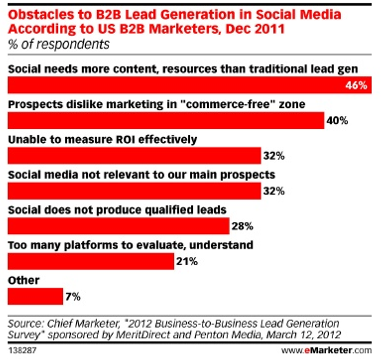
Get your FREE 30-day trial.
Please complete all fields.
![]()
To get your marketing organization to embrace social, you’ve got to show them how it leads to more pipeline. No one doubts that a social revolution is taking place, but if you can’t make that connection and help people visualize the future, it will be hard to drive your social transformation.
------------------------Free Webinar------------------------
Learn more about How to Grow Your Business with Social and Inbound Marketing by registering for a free webinar with Mark Roberge, VP of Sales at HubSpot & Jamie Grenney, VP of Social at Salesforce.
------------Thursday, July 26 at noon EST------------
eMarketer did a great survey on obstacles to B2B lead generation in social media and I think they hit the nail on the head. These are the types of challenges we encounter over and over again.

To drive social transformation you’ve got to get good at addressing these challenges head on.
“Social needs more content, resource than lead gen” -- There’s no denying that. If you compare content marketing to search, it is certainly a whole lot easier to create text ads and run your AdWord’s campaign whenever you have program dollars. On the flip side, if you build up a social media following and have hundreds of posts generating inbound links, you own that traffic and over time, you drive down your cost per acquisition.
“Prospects dislike marketing in commerce free zones” -- Once again, it’s true. Social is best looked at as lead nurturing at the top of the funnel. You’ve got to think about what content will resonate with people who are not yet warm to the brand and offer product-agnostic information to get them a step closer to the brand.
“Unable to measure ROI effectively” -- There is no doubt it is tricky. It’s more challenging measuring a non-linear process that happens at the top of the funnel vs. something that happens on your website. That said, it can be done. One way is to put a value on what a like, a share, or a subscriber is worth to your company and calculate it out to see if it is material. The other way is to connect your social campaigns to soft offers. For example, ask people to provide their email to download the eBook, and track it as a lead. From there you can track lead to close rates and average deal size.
“Social Media isn’t relevant to our main prospects” -- There are going to be holdouts who are not on Facebook and Twitter, but that doesn’t mean it makes sense to write off social. Chances are if you’re buyer spends time online, they’re researching stuff online. It could be that you’re better off focusing on blogs, YouTube, or LinkedIn so that you can meet your target audience where they live. It is also important to note that your goal could be to influence their influencer. For example, if you’re going after the CIO, can you create awareness amongst those people who report to them? Can you equip them with what they need to become your best advocate?
“Social does not produce qualified leads” -- As mentioned above, it is best to think of social as lead nurturing at the top of the funnel. Your goal is to warm them to the brand and see if you can form a connection using soft offers. For example, if you can get them to provide their email to download an ebook, that might be a name that you put into a lead nurturing campaign. The MQL (Marketing Qualified Lead) to Customer Close Rate might be 1% for an eBook download, 1.5% for a Webinar, and 10% for a Contact Me request. If you have an eBook that generates 5,000 leads, that may be more cost effective than buying “hot leads” from Google.
“Too many platforms to evaluate, understand” -- You can make huge inroads with social by spinning up a blog. It is said that companies who blog have 55% more website visitors and 79% more Twitter followers. Secondly, you can always use social media monitoring platforms like Radian6, which aggregates in one place all your brand mentions from across Twitter, Facebook, blogs, forms, and even mainstream news. This will save you time and make it easier to see the big picture. Finally, if you really need to narrow down your choice, focus on your blog and pick networks where your audience spends most of their time. More often than not that is Twitter and Facebook.
So that is a quick introduction to how you might approach the most common objections. In part two in this series we’ll talk about the campaigns process map and how the playbook is evolving with the rise of social.
Before we wrap up we want to hear from you.